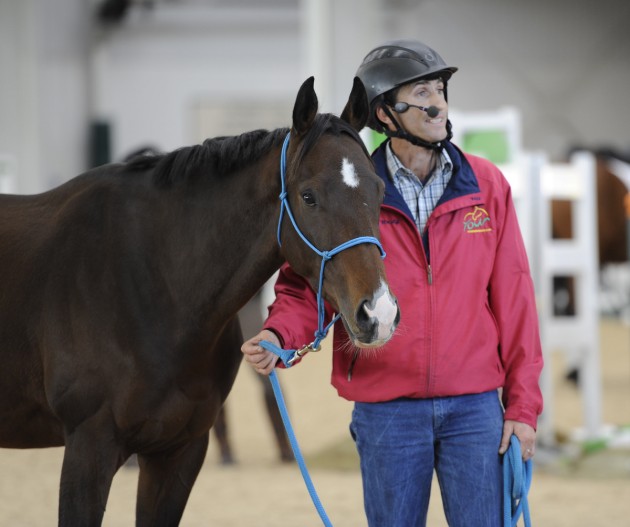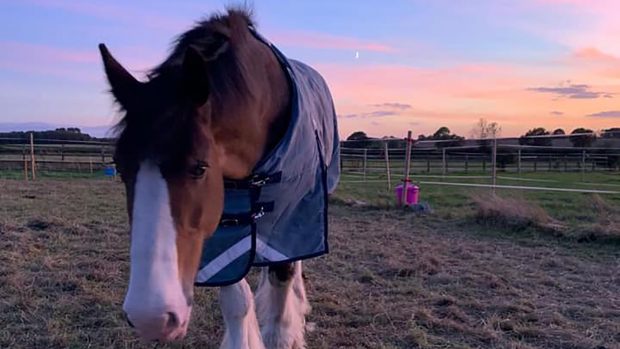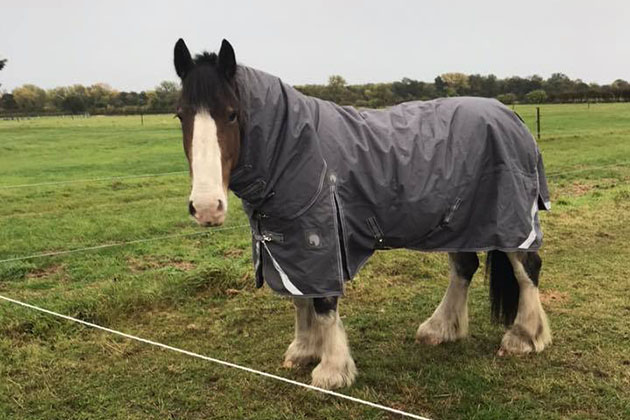I must start off by wishing William Fox-Pitt a full and speedy recovery. All of us who enjoy having horses in our lives understand they come with risks but when an injury happens to such an iconic and successful rider it is particularly shocking and a stark reminder that we should never take our safety for granted. All our thoughts are with his family and friends at such a difficult time.
In my last blog I mentioned a couple of events that I had coming up, and now that they are done and have gone well I will admit to breathing a sigh of relief!
I was asked to demonstrate at the BHS welfare conference at Aintree Racecourse (pictured top and below) ; a great honour that I was very excited about. However, at the same time I knew I would be talking and working with unknown horses in front of a very knowledgeable audience, including those who train horses differently to me.
Although I am confident in my methods and happy to put myself into the public domain, I also accept that there are going to be those who are skeptical about what I do and any mistakes will get plastered all over the internet! It does put on additional pressure but like competition riders, you have to find a way to deal with it.
The event itself gave fascinating views of welfare issues and latest research into horse behavior and I picked up plenty of tips that will help me in my training.
I worked with two horses kindly provided by the Thoroughbred Rehabilitation Centre. One was a young filly (below) just out of training that I did some groundwork with and the second was an older horse who was competing in Riding Club activities.

As the talks during the day were focused on horse-based studies, I decided to look at how human behavior affects the horse. On the ground, I demonstrated how the way the handler moves affects the horse and gave the audience three simple exercises that allow you to stay in control and prevent habits from forming, such as your horse pushing past you or pulling away from you. I also talked about the sequence of communication when you ask your horse to perform a movement and the importance of consistency in your actions.
With the ridden horse, I looked at riders’ balance as the connection between the horse and rider is compromised every time there is a loss of balance.
I showed the four “seats” that I believe every rider should have and practice; I call them the “dressage”, the “jockey”, the “hunting” (think jumping over a hedge with an unseen drop the other side!) and the “cowboy”!
I also spoke about the importance of having a plan to deal with any flight or fight situations. I use a simple exercise that involves being able to bend your horse and disengage the hind end in order to diffuse potentially dangerous situations.
The feedback was very positive from the BHS and TRC and I ended up enjoying myself despite my initial nerves! It was also interesting that they particularly enjoyed hearing me speak about why I use the methods I do, the differences between negative and positive reinforcement and their uses in training horses.
The second event was an equine assisted leadership day that I ran with performance psychologist Charlie Unwin in his capacity as senior consultant with management consultancy, Lane4.
We worked with 32 future leaders from Jardine Lloyd Thompson, a leading multinational insurance company. The day went very well and as always with this type of work it is very refreshing to work with people who haven’t handled horses before.

The leadership day
The idea behind the day is that by learning how to handle horses, the delegates become more aware of their leadership styles and the affect they have on their staff and to learn more productive management strategies in the workplace. It is very striking how their personalities and management styles are reflected in the way they handled the horses and how it relates to business.
For example, some were quite forceful and relentless with the horses, not giving them any time to reflect. The horses ended up becoming increasingly unwilling and harder to move. As this happened, they began to realise that although “time is money” in the corporate world, their teams could be a lot more productive and successful by giving people thinking time in order to reflect, consider and learn; just like they had to do to get the horses to move how they wanted them to!

The leadership day
These kinds of events are enjoyable to do, but I do love getting back to the yard and training horses. I have spoken before about the fact that these days in order to run a business like mine it is not just about riding, but using other tools such as increasing your online presence in order to develop things.
At the moment I am trying to get to grips with talking to a computer in my monthly webinars for Your Horsemanship members; it is very disconcerting talking to yourself and realising that you are being watched by others in their living rooms!
This week I also did a strange interview with politician Lembit Opik for his BBC Kent radio show about the theory that the Australian accent derived from the fact the first settlers were drunk most of the time and slurred their words!
Apparently I was asked because when you Google ‘Australians in Kent’ I sounded the most unusual. I’m not sure whether to take that as a compliment or not!
I will finish the blog on the Aussie theme and say: “Come on you Green & Golds” in the Rugby World Cup Final. It will be a tense Saturday afternoon with perhaps just a little drunken slurring!
Jason



